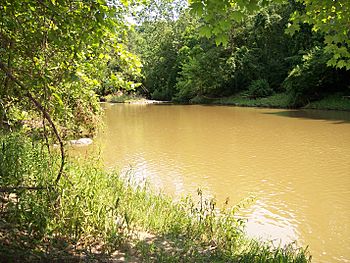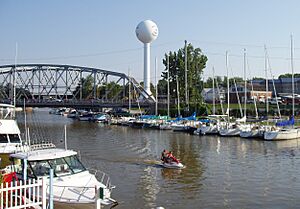Vermilion River (Ohio) facts for kids
Quick facts for kids Vermilion River |
|
|---|---|

The Vermilion River at the community of Birmingham in Erie County
|
|
| Country | United States |
| Physical characteristics | |
| Main source | Bailey Lakes, Ohio |
| River mouth | Lake Erie at Vermilion, Ohio |
| Length | 66.9 miles (107.7 km) |
| Basin features | |
| Basin size | 268 sq mi (690 km2) |
The Vermilion River is a river located in northern Ohio, United States. It flows for about 66.9 miles (107.7 km) and empties into Lake Erie. The river drains an area of about 268 square miles (694 km²). Its name comes from the reddish clay found along its banks, which often makes the river look muddy after it rains.
Where Does the River Flow?
The Vermilion River starts at Mud Lake in Bailey Lakes, Ohio, which is in Ashland County, Ohio. It generally flows north through Huron County, Ohio, Erie County, Ohio, and Lorain County, Ohio. Along its path, it passes by towns like Savannah, Ohio and Wakeman, Ohio. The river finally reaches Lake Erie at the city of Vermilion, Ohio.
Just before the river flows into Lake Erie, near State Route 2, it goes through a deep gorge. You can visit a rest area along Route 2 in Vermilion, Ohio that has a short nature trail. This trail leads to a great view of the gorge. An important archaeological site called the Franks Site is located on top of the gorge walls. This was once a large village where the Erie people lived.
The Vermilion River also has smaller streams that flow into it, known as branches or forks. The Southwest Branch Vermilion River and the East Branch Vermilion River join the main river in Huron County. The East Fork Vermilion River begins in Lorain County and meets the Vermilion River in Erie County.
What Animals Live in the River?
The Vermilion River is home to many different kinds of fish and other aquatic animals. Each fall and spring, the Ohio Department of Natural Resources (ODNR) releases steelhead trout into the river. This is the westernmost river in Ohio where the ODNR stocks these fish every year. In late spring, the steelhead trout return to Lake Erie for the summer and come back to the river in the fall.
Besides steelhead trout, the river is also home to:
- Smallmouth bass
- Largemouth bass
- Rock bass
- Channel catfish
- Bullhead
- Longnose gar
- Various types of suckers
- Bluegill
- Sunfish
- Carp
- Crappie
- Freshwater drum
- Different kinds of minnows and darters
- Crayfish
- Many types of aquatic insects
How Did the River Get Its Name?
The name "Vermilion River" has been used since at least 1760. Early explorers like George Croghan recorded it in their journals. The name "Vermilion" refers to a reddish color. It is believed that the first European explorers saw the local Native Americans using the purplish-red clay from the riverbanks as body paint. They mixed it with bright red berry juices. The explorers thought this mixture was similar to a valuable European substance called 'vermillion'. Even though the body paint was actually made from brownish-purple mud, the name "Vermilion" stuck.
For a long time, the river's name was spelled "Vermillion" with two 'L's. However, around the end of the 1800s, the second 'L' was dropped. This was likely done to avoid confusion with a township in Ashland County also named 'Vermillion', which is not on this river.
The United States Board on Geographic Names officially decided on "Vermilion River" as the name in 1899. Some other names the river was known by include "Oulame Thepy" and "River en Grys".


